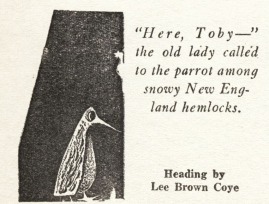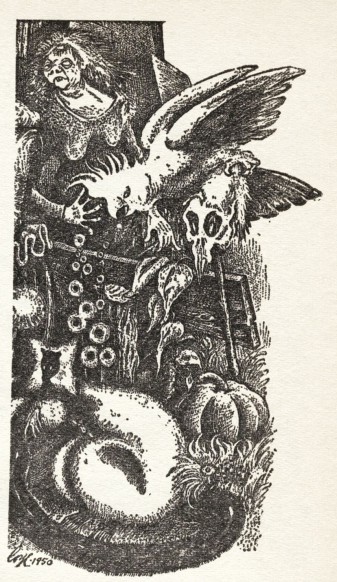Joseph Payne Brennan
Joseph Payne Brennan (1918-1990) would become one of the preeminent horror short story writers of the 1960s and 1970s along with Basil Copper and Ramsey Campbell. Brennan’s first ghost story appeared in Weird Tales in 1952. He would publish four stories with Weird Tales including the classic “Slime”.
But let’s be honest, Brennan came too late to the party. By 1952, Weird Tales was winding down a slow trail to death (along with all the other Pulps). Dorothy McIlwraith was doing what she could but the magazine was not the powerhouse of the 1930s, not even the so-so magazine of the 1940s. The last years of the 1950s produced few new (and good) writers. Richard Matheson published “Wet Straw” in 1954 but he was already establishing himself in the Science Fiction magazines. Some of the old hands like August Derleth, Mary Elizabeth Counselman, Harold Lawlor, Emil Petaja and Paul Ernst still provided stories but not their best.
A Bird and a Ghost


Joseph Payne Brennan made his debut with “The Green Parrot” (Weird Tales, July 1952). It is a pretty standard ghost story but a good indicator of his potential. A writer who is staying in a small town for quiet and work, goes on a drive to relax. He ends up on a remote road where a green parrot flies in front of him. The bird is followed by an old woman in a bonnet. The narrator goes after the parrot and becomes lost. He struggles out of the thick brush and drives back to his hotel in a huff. There he tells the others at his table about the experience. Their astonished faces tell him there is more here.
It turns out many people have seen the bird and woman, who died over a hundred years. The original Miss Meecham had sent a rescue party into the woods to retrieve the parrot just before a snowstorm. Several men and boys (and the woman herself) died after getting lost in the woods. Her appearance always predicts a coming snowstorm. The narrator goes to bed, sleeps without difficulty but wakes in the morning to half a foot of snow.
This type of ghost story is very old. It wasn’t even new when J. Sheridan Le Fanu used to write them. That being said, Brennan writes it well, with economy, a must for a good ghost story. Though not a brilliant innovation, he sets himself upon the course of a ghost story writer. Late to the party, he still gets a bit of cake.
Just as an aside, Brennan was lucky enough to get an illustration by Lee Brown Coye, a personal favorite. His psychotic cartoony style is not to everyone’s taste but I like it. Why did Dorothy McIlwraith (or the paste up person) decide to cut it into pieces? I’d like to find the original uncut image.

The Thing From the Bottom of the Sea
“Slime” (Weird Tales, March 1953) is Brennan’s stand-out tale. It follows the life of a black puddle of ooze that leaves its ocean floor home to go for a jaunt on dry land. In the town of Clinton Center, Henry Hossing has some incredible luck. He finds a ten dollar dollar. He eats a two dollar breakfast, and a three dollar lunch, and eventually he arrives at the liquor store. A nice fire and a bottle of whiskey, it looks like it is going to be a nice night for Henry. Until the slime eats him.
Old Man Gowse’s cow, Sarey, goes missing. No one in town will believe him about the slimy stench in the barn. The local druggist believes he heard something in the direction of Wharton’s Swamp. Gowse heads home, angry, when he runs into his unfriendly neighbor, Barnaby and his dog, Jibbe. Gowse tells him about his cow. he says he wouldn’t go into the swamp for ten thousand dollars. Barnaby laugh at him. Jibbe catches a scent and heads off in the direction of the swamp. Barnaby follows, thinking the dog has found a raccoon, when the dog runs away. The hunter, as a matter of pride, pushes on to be eaten by the slime.
The next morning Gowse finds Jibbe, then gets the police. Chief Underbeck stalls for a day, unsure if Barnaby won’t show up on his own. He is about to decide on a search in the morning when an old man brings in a distraught girl. She ran in front of his car, screaming her head off. Her names is Dolores Rell and she lived near Stantonville. She and he fiance, Jason Bukmeist, had gone for a drive and stopped near Wharton’s Swamp. Something had come out of the trees to devour him. “O God– the darkness came alive! The darkness came alive!” she screams.
A search the next day turns up evidence of all three deaths, but the searchers misinterpret the evidence. They think Hossing murdered the others. Underbeck creates small groups to search through the night for the killer. Fred Storr and Luke Matson are on the midnight to 3 am shift. The slime eats Luke, then goes after Storr. The deputy flashes his light at the monster, stopping it in its tracks. When others show up, the monster flees.
Underbeck finally puts all the pieces together and calls in the army. The soldiers don’t find anything except an owl, a bobcat and a copperhead. The Chief isn’t discouraged and plans for another night of patrols. He even sets guards along the beach. This proves good fortune for the slime decides to flow back to the sea. The creature gets caught on a barbed wire fence, giving the soldier with the flamethrower time to roast it.
Joseph Payne Brennan has written a 1950s horror film just a few years before Hollywood went in that direction. The Blob, probably the closest to this story, would appear in 1958. His story follows the plot of most films of this sort: introduce monster, kill several victims, destroy it at the end. To my knowledge, no producer ever gave Brennan credit.

One Night in a Hotel
“On the Elevator” (Weird Tales, July 1953) has an unnamed hotel night clerk sitting through a severe storm. Being as the Atlas Hotel is on the seaside, the ocean waves are loud and the night wet. Reading a book, the clerk fails to notice when a figure in a long black raincoat goes into the elevator. The clerk ends up running up stairs, talking with the woman in 311, who insists the man had no face, and eventually leading the cops to the basement where they find Mr. Traverson.
The man has been torn to shreds. “He had been savagely attacked. His face had been slashed until his features were unrecognizable. His throat was torn, and deep ragged gashes had been made in the jacket of his smart gray tweed jacket. They were so deep that they had penetrated all his clothing and blood oozed up out of them.” The cops insist it was done with a weapon. The clerk: “Well, if you ask me chum, that murderin’ thing in the black raincoat was something dead that came up out of the sea!”

Terror in a Box
“The Calamander Chest” (Weird Tales, January 1954) tells the story of Mr. Maax, who buys a calamander chest from the junk dealer, Kinkle. At night the chest opens and Maax can see a gray finger poking out. He locks it but it makes no difference. He decides to get rid of the thing. When the junk removal men come, they think the trunk is too nice to take to the dump and burn. He pays another man ten dollars (with another ten after the job is done) but his truck breaks down, delaying the removal for another night.
Maax endures the chest for another night. He sees the finger again and opens the lid to investigate. In the morning Mr. Maax is not home when the removal men come. One of the men recognize the box as the one from Kinkle’s. He knows the story behind it and tells it to the other guy. The trunk originally belonged to old Henry Shumberton. The man had been murdered and placed in the chest. Only he didn’t die right away. His finger was found scratching the wood, trying to open the lock. The men throw the truck in the river, but never collect the other ten bucks. Maax is never seen again.
In the end, Joseph Payne Brennan’s Weird Tales catalogue holds three traditional ghost stories, similar to what August Derleth wrote decades earlier, and one Lovecraftian monster-fest. H. P. Lovecraft was one of Brennan’s influences. He would write an actual Mythos tale, “The Willow Platform” in 1977.
Weird Tales’ last issue appeared in September 1954. Brennan had lost his best market for supernatural fiction. And there were none to replace it. The paperback anthologies of the 1960s were a decade away. So where do you publish? For Brennan the answer was publish your own magazine. Macabre‘s first issue is dated Winter 1957. It ran twice a year until 1966, when it became an annual until the last issue in 1976. A total of 23 issues, each featuring at least one (often more) poem or story by Brennan. Several would contain the first stories of his occult detective Lucius Leffing.
But Brennan’s career doesn’t end there. He would collect his stories in 18 collections, including Nine Horrors and a Dream (1958), Nightmare Need (1964) and Stories of Darkness and Dread (1973) with Arkham House. He wrote the novel Evil Always Ends (1984) for Donald M. Grant. He wrote dozens and dozens of poems, wrote non-fiction about H. P. Lovecraft and sold regularly to the Mystery digests, Alfred Hitchcock Mystery Magazine and Mike Shayne Mystery Magazine. Weird Tales had been the opening door to a long and distinguished career.



